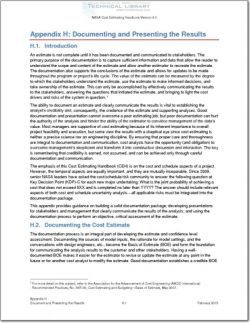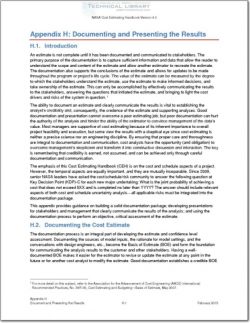NASA-CEH-APP-H

- Version
- 131 Downloads
- 204.21 KB File Size
- 1 File Count
- August 14, 2016 Create Date
- August 14, 2016 Last Updated
Appendix H; Documenting and Presenting the Results

H.1. Introduction
An estimate is not complete until it has been documented and communicated to stakeholders. The
primary purpose of the documentation is to capture sufficient information and data that allow the reader to
understand the scope and content of the estimate and allow another estimator to recreate the estimate.
The documentation also supports the conclusions of the estimate and allows for updates to be made
throughout the program or project’s life cycle. The value of the estimate can be measured by the degree
to which the stakeholders understand the estimate, use the estimate to make informed decisions, and
take ownership of the estimate. This can only be accomplished by effectively communicating the results
to the stakeholders, answering the questions that initiated the estimate, and bringing to light the cost
drivers and risks of the system in question. 1
The ability to document an estimate and clearly communicate the results is vital to establishing the
analyst’s credibility and, consequently, the credence of the estimate and supporting analyses. Good
documentation and presentation cannot overcome a poor estimating job, but poor documentation can hurt
the authority of the analysis and hinder the ability of the estimator to convince management of the data’s
value. Most managers are supportive of cost estimating because of its inherent importance to overall
project feasibility and execution, but some view the results with a skeptical eye since cost estimating is
neither a precise science nor an engineering discipline. By ensuring that proper care and thoroughness
are integral to documentation and communication, cost analysts have the opportunity (and obligation) to
overcome management’s skepticism and transform it into constructive discussion and interaction. The key
is remembering that credibility is earned, not assumed, and can be achieved only through careful
documentation and communication.
The emphasis of this Cost Estimating Handbook (CEH) is on the cost and schedule aspects of a project.
However, the temporal aspects are equally important, and they are mutually inseparable. Since 2009,
senior NASA leaders have asked the cost/schedule/risk community to answer the following question at
Key Decision Point (KDP)—C for each new major undertaking: What is the joint probability of achieving a
cost that does not exceed $XX and is completed no later than YYYY? The answer should include relevant
aspects of both cost and schedule uncertainty analysis—all applicable risks must be integrated into the
documentation package.
This appendix provides guidance on building a solid documentation package; developing presentations
for stakeholders and management that clearly communicate the results of the analysis; and using the
documentation process to perform an objective, critical assessment of the estimate.
| File | Action |
|---|---|
| NASA-CEH-APP-H Appendix H; Documenting and Presenting the Results.pdf | Download |

Comment On This Post